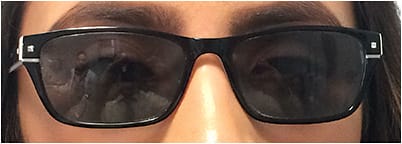
Prosthetic Lens for Phthisis Bulbi and Band Keratopathy
A 15-year-old Hispanic female presented for a second opinion regarding her left eye. She had a history of blunt trauma OS from a fence post as a child, which caused a total retinal detachment with no vision. Over time, her left eye began to change, and she wore sunglasses at all times to hide this disfigurement (Figure 1). She and her mother inquired as to whether anything could be done to hide her disfigurement other than sunglasses, especially given the patient’s upcoming quinceañera.

EXAM FINDINGS
The entrance testing, vision, and slit lamp examination of the right eye were all unremarkable. The left eye exhibited no light perception, mild ptosis, mild esotropia, and significant corneal opacification (Figure 2). Structures posterior to the cornea were not readily visible. A b-scan was attempted but was unreliable. All posterior structures OD were unremarkable, and refraction was plano DS (20/20). The patient was diagnosed with phthisis bulbi, band keratopathy, esotropia, and pseudoptosis OS.

To cover the disfigurement as much as possible, we recommended a large, hand-painted contact lens. Iris color, vasculature, sclera, and pupil size were all measured on the normal right eye. The patient was fit with a 15mm clear conventional contact lens before painting to ensure good comfort and an appropriate fit. The first clear lens was too steep, producing an air bubble, but this resolved with a flattened base curve (Figures 3/Video 1 and Figure 4/Video 2). Because the disfigured eye was non-seeing, a black pupil was included for a more natural look. Additionally, due to the esotropia, we decided to have the painting done off-axis for better alignment. Using Purkinje images, a black dot was marked on the center of the image while on the eye to assist with off-axis painting. Upon receiving the contact lens, the patient noted improved cosmesis and sufficient comfort. The contact lens was dispensed, and the patient was instructed to return for follow-up.



DISCUSSION
Phthisis bulbi signifies end-stage eye disease; it is characterized by shrinkage and disorganization of the eye and resultant functional loss.1 Phthisis bulbi may occur after a severe injury to an eye that causes it to become atrophic. As the eye shrinks, it may result in pseudoptosis of the eyelid along with other associated findings such as a sensory strabismus or band keratopathy.1 Enucleation may be considered but could cause complications.
The advanced scarring of phthisis bulbi may become unsightly, and patients often try to hide this disfigurement. Options for masking the disfigurement may include in-office contact lens tinting, computer-generated colored contact lenses, hand-painted contact lenses, or a painted scleral shell.2 A traditional ocular prosthetic (reform) is not usually considered with phthisis bulbi unless it is very advanced.2 Therefore, a painted scleral shell would be more appropriate due to its reduced thickness for most cases. A painted scleral shell could have been considered for this patient, but cost and potential loss would still have been an issue for her. When deciding what treatment option is best, it may be helpful to use the classification below:2
Class I: Corneal opacity with no enophthalmos and normal sclera.
Class II: Corneal opacity with mild enophthalmos and normal sclera.
Class III: Moderate enophthalmos with disfigured sclera.
Class IV: Severe enophthalmos with disfigured sclera and loss of orbital fat.
Class I patients may be fit in a simple prosthetic or cosmetic lens. Due to enophthalmos, Class II patients may require an acrylic resin or a silicone scleral shell. Class III and IV patients will likely require a scleral shell or a traditional ocular prosthetic due to their advanced atrophy. Our patient’s eye was a Class II, but she was still able to wear a soft contact lens that met her needs. If patients have sensitive corneas, they may require additional surgery to reduce sensation, thereby gaining better tolerance of a scleral shell.3
In-office tinted contact lenses are used less frequently due to reasons such as time commitment, lack of detail, and limited tinting systems.
CONCLUSION
Although phthisis bulbi leaves a patient with limited or no vision, treatment options are still available. Thorough discussion with patients will help guide what treatment option is best. Computer-generated, in-office tinted, and hand-painted contact lenses are successful ways to hide the condition while making the patient’s appearance more natural.
REFERENCES
- Tripathy K, Chawla R, Temkar S, et al. Phthisis Bulbi-a Clinicopathological Perspective. Semin Ophthalmol. 2018;33(6):788-803.
- Aggarwal H, Singh RD, Kumar P, Gupta SK, Alvi HA. Prosthetic guidelines for ocular rehabilitation in patients with phthisis bulbi: A treatment-based classification system. J Prosthet Dent. 2014 Jun;111:525-528.
- Ding J, Chen T, Hou Z, Qin Y, Hao L, Li D. Cosmetic shell fitting over a sensitive cornea in mild phthisis bulbi using total conjunctival flap. Aesthetic Plast Surg. 2013 Apr;37:398-401.



